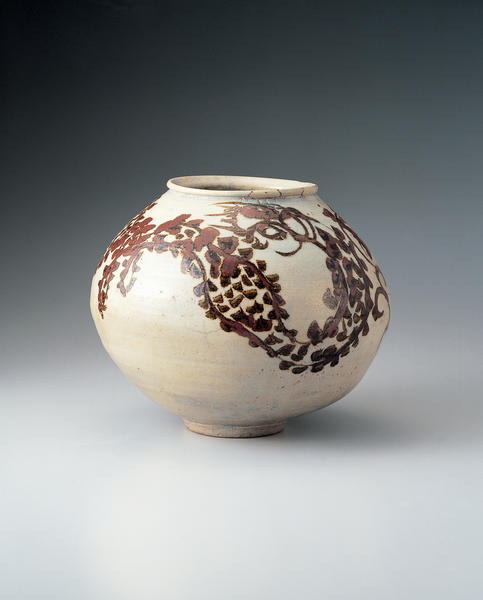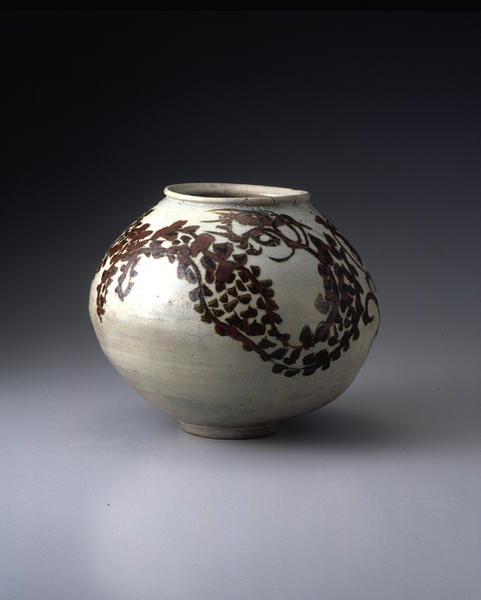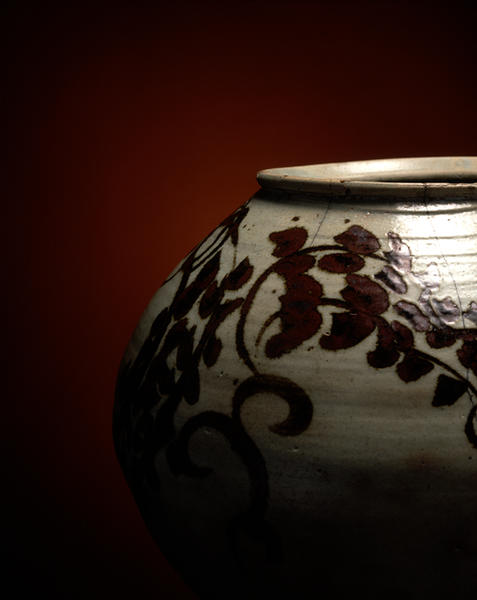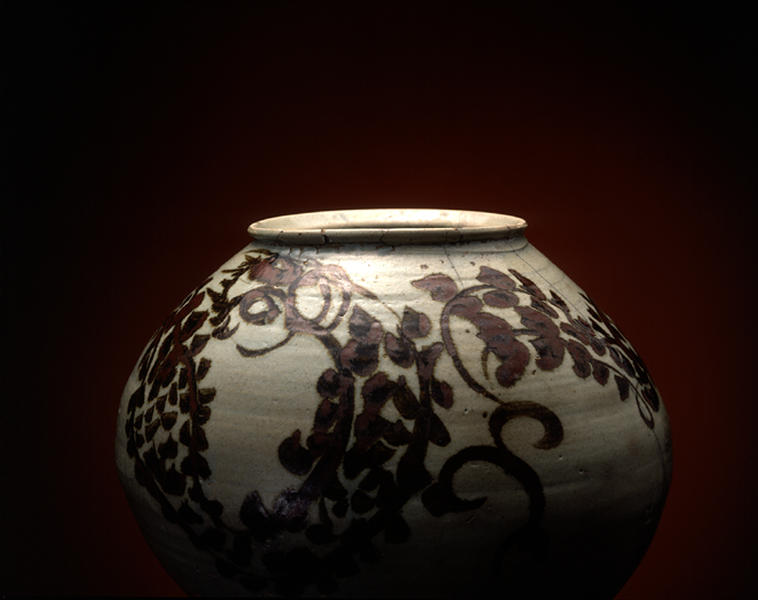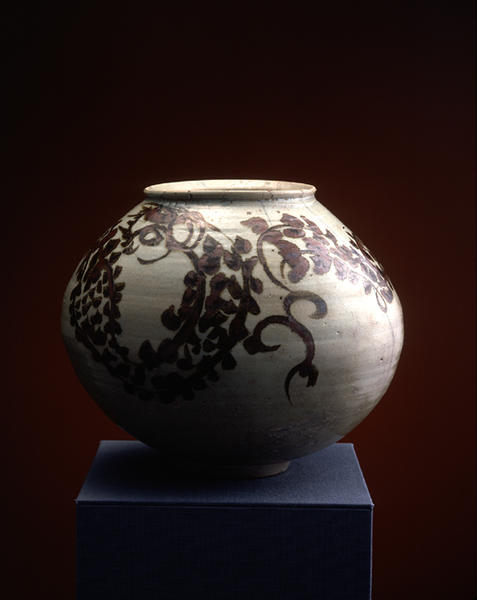鉄砂竜文壺
- 朝鮮王朝時代
- 17c
- 白磁
- H-26 D-32
1392年に高麗国王を追放した李成桂が建てた王朝を朝鮮王朝(李氏朝鮮=李朝)という。仏教にかわって儒教を国教とし1910年までの518年間続いた長期王朝である。朝鮮王朝時代の陶磁は、高麗時代とは大きく様相を異にする。高麗では青磁がもっぱら好まれ「翡色青磁」という独特の青磁を生みだしたが、朝鮮王朝では、初期にその流れをくむ粉青沙器が盛行するものの、やがて白磁が主流となる。そこには多様な作風が見られ、中期(十七世紀中~十八世紀中の約100年間)には白磁だけでなく、染付、鉄砂などが現れた。
竜文は広く流行した図柄のひとつで、厳格な筆致のものと抽象化された戯画風のものとに大別される。中期には後者がよく見られ、この壺もそのうちのひとつといえる。広い口縁部に小さく締まった高台、胴は中央部で強く張り出した算盤玉形をなしている。釉色はやや青みを帯びているが胴部から底部にかけてところどころに赤い斑紋と大きく赤みを帯びた部分が見られ、高台内の釉には縮みが生じている。どこか高麗茶碗に通じる釉調が感じられる。描かれている竜は稚拙な運筆ではあるが鉄砂の発色はよい。この壺は力強い器形であると同時に、自由で素朴な空気を醸し出している。
解説(開館1周年記念展)
1392年に高麗国王を追放した李成桂が建てた王朝を朝鮮王朝(李氏朝鮮=李朝)という。仏教にかわって儒教を国教とし,1910年までの518年間続いた長期王朝である。朝鮮王朝時代の陶磁は,高麗時代とは大きく様相を異にする。高麗では青磁がもっぱら好まれ「翡色青磁」という独特の青磁を生み出したが,朝鮮王朝では,初期にその流れをくむ粉青沙器が盛行するものの,やがて白磁が主流となる。そこには多様な作風が見られ,中期(17世紀中頃~18世紀中頃の約100年間)には白磁だけでなく,染付,鉄砂などが現れた。
竜文は広く流行した図柄の一つで,厳格な筆致のものと抽象化された戯画風のものとに大別される。中期には後者がよく見られ,この壷もそのうちの一つといえる。広い口縁部に小さく締まった高台,胴は中央部で強く張り出した算盤玉形をなしている。釉色はやや青みを帯びているが,胴部から底部にかけてところどころに赤い斑紋と大きく赤みを帯びた部分が見られ,高台内の釉には縮みが生じている。どこか高麗茶碗に通じる釉調が感じられる。描かれている竜は稚拙な運筆ではあるが,鉄砂の発色はよい。この壷は力強い器形であると同時に,自由で素朴な空気を醸し出している。
Catalogue Entry
Yi dynasty was the Korean dynasty that Yi Song-gye established by banishing the king of Koryo in 1392. This was a dynasty which survived for 518 years, until 1910. In this dynasty, Confucianism was adopted as a state philosophy to live by and took the place of Buddhism. Ceramics in the Yi dynasty period are markedly different from those in the Koryo dynasty era. In the Koryo era, celadon was quite popular, and a unique type of celadon known as jade-colored celadon, was created. In the early Yi dynasty period, Punch'ong ware, which descended from the jade-colored celadon, was extremely valued, but it slowly gave way to white porcelain. A diverse range of artistic styles are found at this time. To wit, in the middle period, for about 100 years (from the mid-17th to the mid-18th century), artisans produced not only white porcelain, but also white porcelain with a design painted on underglaze cobalt blue and white procelain with designs in underglaze iron brown, to name a few. Dragon designs, which were some of the most fashionable designs of the time, can be grouped into two major types those executed in precise brushwork, and those done in the abstract with humor. The latter type, as is this jar, is more often seen in the middle period. The present jar has a wide, round mouth, a small foot, and a round, prominent body with an overall shape of a bead on an abacus. It is covered with bluish glaze. On its lower body, red motley spots and a large area of reddish coloration are noted. Inside the foot, the glaze appears wrinkled. Its glaze style is suggestive of Koryo tea bowls. Although the dragon on this jar is by no means skillful, the iron underglaze took color very well. The shape of this jar is quite powerful; it is free and, at the same time, simple.
